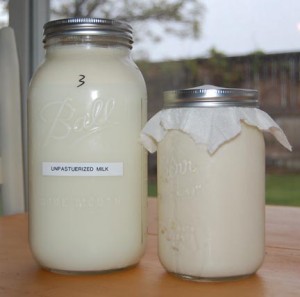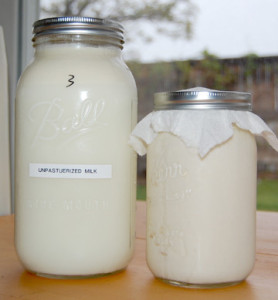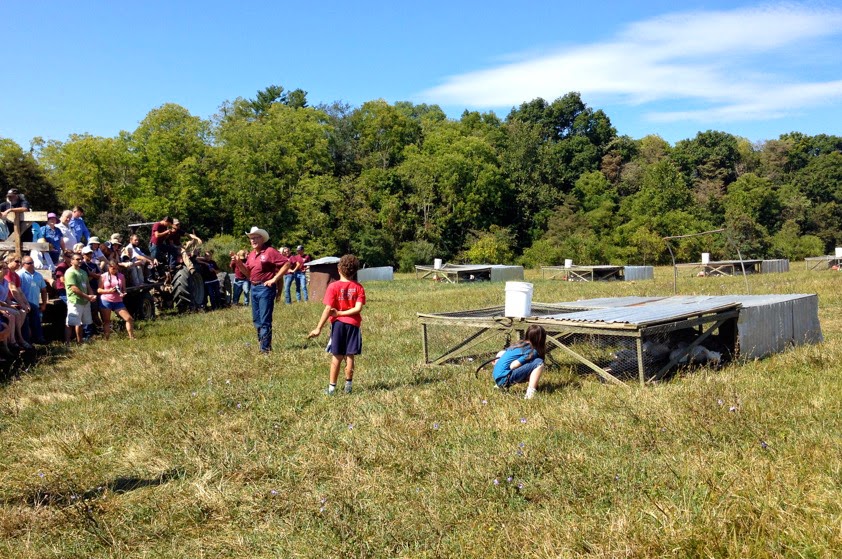
Jars of raw milk (L) and raw milk kefir (R). Click on the image to see about 2″ of cream on top of the milk.
Ironically, I live in a state where the sale, purchase, growth and consumption of marijuana is legal, but raw (unpasteurized) milk and other dairy products are not. Federal laws prohibit both. If the federal government wants to make trouble, it can and will raid either one of these operations. But more often than not, it’s the dairy farmers, usually Amish, that have their farms raided, at gunpoint, their dairy products destroyed and businesses shut down. The farmers are charged with state or federal crimes and off to court they go. Hopefully the FTCLDF steps in.
Why? Federal law says:
“No person shall cause to be delivered into interstate commerce or shall sell, otherwise distribute, or hold for sale or other distribution after shipment in interstate commerce any milk or milk product in final package form for direct human consumption unless the product has been pasteurized or is made from dairy ingredients (milk or milk products) that have all been pasteurized…” 21 CFR Sec. 1240.61

Meeting the cows at Johnson’s Acres.
Most states have found a way around the federal law, by technically not selling raw dairy products. Such as, here in Colorado, I was able to purchase a share in a dairy herd. I have a written and signed contract. A dairy farmer boards my fraction of a cow for a monthly fee. I am not buying milk; I am paying to board cows. Any milk produced by my cow is legally mine to consume. Your state raw dairy laws can be found here.
Why was raw milk outlawed?
According to the US Food and Drug Administration, the CDC reports that unpasteurized milk is 150 times more likely to cause food borne illness than pasteurized products. And between the years 1993 and 2006, more than 1500 people in the US became sick from consuming raw dairy products.
But, a rebuttal from Realmilk.com says:
“Based on data in a 2003 USDA/FDA report: Compared to raw milk there are 515 times more illnesses from L-mono due to deli meats and 29 times more illness from L-mono due to pasteurized milk. On a PER-SERVING BASIS, deli meats were TEN times more likely than raw milk to cause illness (Interpretive Summary – Listeria Monocytogenes Risk Assessment, Center for Food Safety and Applied Nutrition, Sept. 2003, page 17).”
I can’t help but recall that over the past several years, reports of wide-spread food borne illnesses in the US have been due to contaminated meats, fruit, vegetables and pasteurized ice cream — with not one mention of raw dairy products. Do I smell bias?
What’s wrong with pasteurized/homogenized milk?

A healthy calf being fed raw milk right from the source!
“Pasteurization destroys enzymes, diminishes vitamin content, denatures fragile milk proteins, destroys vitamins C, B12 and B6, kills beneficial bacteria, promotes pathogens and is associated with allergies, increased tooth decay, colic in infants, growth problems in children, osteoporosis, arthritis, heart disease and cancer. Calves fed pasteurized milk do poorly and many die before maturity. Raw milk sours naturally but pasteurized milk turns putrid; processors must remove slime and pus from pasteurized milk by a process of centrifugal clarification. Inspection of dairy herds for disease is not required for pasteurized milk.”
“Homogenization is a process that breaks down butterfat globules so they do not rise to the top. Homogenized milk has been linked to heart disease.”
“Many studies have linked consumption of pasteurized milk with lactose intolerance, allergies, asthma, frequent ear infections, gastro-Intestinal problems, diabetes, auto-Immune disease, attention deficit disorder and constipation. During a period of rapid population growth, the market for fluid pasteurized milk has declined at 1% per year for the past 20 years. Fewer and fewer consumers can tolerate pasteurized (and ultrapasteurized) milk (Don’t Drink Your Milk, Frank Oski, MD, 1983).”
 Benefits of Raw Milk
Benefits of Raw Milk
Raw milk (ideally–check your sources) comes from dairy cows that have not been genetically engineered to produce more milk than their bodies would normally produce. Real “old fashioned” cows are naturally healthy, exist on a diet of pasture grass and do not need to be pumped full of antibiotics or growth hormones. The milk produced is nutrient dense, with high levels of fat-soluble vitamins, fatty acids and other nutrients.
Many people who are lactose intolerant (80%+) have no problem digesting raw milk. It’s thought that enzymes contained in raw milk help break down the lactose. The enzymes are destroyed by pasteurization.
There is substantial evidence that consumption of raw milk during childhood may protect against asthma, allergies and other immune-mediated diseases.
Research suggests that raw milk contains antimicrobial components that are absent in pasteurized milk—pathogens intentionally introduced into raw milk tend to die off.
Raw milk is produced by small, local dairy farms which are focused on sustainability. This is better for both community and the environment, not to mention the health and humane treatment of the cows vs. the mass production of milk by “factory farming.”
More detailed information and references for the above statements can be found here: http://www.realmilk.com/
It’s a Personal Choice
Not actually ever having liked milk, I decided to give raw milk a try since I’d read so much about its benefits. And being told I cannot do something is always incentive. Surprise! I not only like raw milk, my body craves it! I make my own (cultured) kefir, which I drink and use in various recipes (that will be another post, another day) instead of buttermilk or sour cream.
I found (through the realmilk.com web site) a dairy farmer, Kenny Johnson of Johnsons Acres, who sells herdshares, provides raw milk to the shareholders and is passionate about responsibly producing the raw milk that he feeds his own children and countless other people. I drove out to see his operation in person. He has a pasture with happy, healthy, grazing cows and a milking barn that absolutely sparkles with cleanliness, a sterilization machine for the half gallon jars and plenty of refrigeration.
The jars of milk are delivered weekly to distribution centers (volunteers’ houses) throughout the Denver area. I drive to the distribution house in my area, covertly let myself into the garage and their raw-dairy-only refrigerator—and trade my washed, empty milk jar for a full one.
Do your homework!
If you decide to try raw dairy for yourself, I highly recommend that you:
• Make sure the dairy farm is reputable and doing everything possible to produce sanitary and high quality products. I would not buy from a ranch that I could not visit in person. There is nothing better than personally meeting the farmer who you will trust to produce a safe and high quality product.
• Meet the cows! Make sure the cows are real, old-fashioned dairy cows and not the “modern” Holsteins, bred to produce 3x the amount of milk than the norm. These would include Jerseys, Guernseys, Red Devons, Brown Swiss, Milking Shorthorns, Dutch Belted and, older genetic lines of Holsteins. Check their living conditions and observe whether they look happy and healthy.
• Ask what the cows are eating: they should be pasture-fed on grass, with dried grass/hay supplemental feeding in the winter, for the health of the cow and the highest quality, most nutritious milk. Cows are supposed to eat grass. No gmo or non-organic grains! No antibiotics, they should not be necessary! No growth hormones!
• Inspect the milking and processing barn. They should be clean and probably smelling a bit like Chlorox.
Use your common sense (and intuition) to decide whether you want to buy raw dairy products from one farmer or another. And remember that you do have the right to choose to consume raw dairy products. Or anything else for that matter. I can do without the marijuana. 🙂














